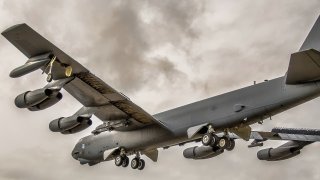B-52 Stratofortress: The 'Old' Bomber the U.S. Air Force Can't Retire
The B-52 Stratofortress, first flown in 1952, remains a key asset for the U.S. Air Force. Despite its age, the B-52 will continue serving into the mid-21st century, with potential to last nearly 100 years.
Summary: The B-52 Stratofortress, first flown in 1952, remains a key asset for the U.S. Air Force. Despite its age, the B-52 will continue serving into the mid-21st century, with potential to last nearly 100 years.
-Its longevity is due to its adaptability, capable of launching long-range cruise missiles and potentially hypersonic weapons, making it relevant against modern threats.
-The B-52's extended range and versatility enable it to counter sophisticated A2/AD defense systems, maintaining its strategic importance.
B-52 Stratofortress: The Timeless Titan of U.S. Air Power
The B-52 Stratofortress is probably the most iconic bomber in the world. Created at the start of the Cold War, its service life has been extended until at least middle part of this century. In essence, the legendary strategic bomber will be retired around the hundredth anniversary of its first flight.
That’s an astonishing record for any aircraft, let alone a main bomber in service to the US Air Force, which is known (like the rest of the US Defense Department) for building systems that are notoriously expensive, often don’t live up to their hype, and consistently end prematurely (until Congress stepped in earlier this year, the Air Force was trying to retire some of its old F-22A Raptors). But it is conceivable that we could see pilots of the B-52 today who are piloting the same birds that both their fathers and grandfathers may have once piloted.
A Brief History of the Stratofortress Bomber
The B-52 was designed and had its maiden flight in April 1952. It became an active member of the US Air Force’s fleet a few years thereafter in 1955. The iconic bomber has been featured in an assortment of famous films—from Dr. Strangelove: Or How I Learned to Stop Worrying and Love the Atomic Bomb (1964) to Apocalypse Now (1979) to By the Dawn’s Early Light (1990).
The Stratofortress was built in a time before the internet. Heck, it was deployed at a time when there were no satellite constellations dancing above our heads, few computers, and when television was both still a novelty as well as relegated to but three black-and-white channels (and those television sets were vacuum tube technology).
Yet, the Air Force has decided to extend the lifespan of this bird by another handful of decades. This decision negates the argument that warfare has become so super sophisticated that we’ll need entirely new, expensive systems.
In fact, as I have written repeatedly in these pages, war has been flattened and amalgamated. Yes, high-tech is everywhere. But so, too, is low-tech. And even the high-tech that proves most effective, such as unmanned aerial vehicles—drones—are far cheaper than other advanced platforms the US military has procured for future combat missions.
So, no, the B-52 is not antiquated or irrelevant to a modern, near-peer fight.
Although, the B-52s might not be able to interdict over enemy targets the way that they were able to in the Vietnam War, or in Desert Storm, or in the Global War on Terror (specifically, Afghanistan and Iraq). The B-52s are the embodiment of the old adage, “If it ain’t broke, don’t fix it.” Just look at the body of its service. Look at how technologies have evolved, specifically air defense systems, and how well the B-52 still operates under increasingly difficult circumstances.
The B-52 Can Overcome Modern Anti-Aircraft Systems
Sure, China today has fielded some of the most advanced and comprehensive networks of anti-access/area denial (A2/AD) defense systems. They’ve got sophisticated air defense weapons and tracking capabilities. All these systems are meant to do one thing (beyond the obvious of shooting US warplanes down).
These systems are intended to stunt US military power projection into regions that China covets, such as the South and East China Seas or the Taiwan Strait. But the B-52 is a big bertha and can operate over long distances and fight at farther ranges than can many other Air Force platforms.
China (as well as other American rivals, such as Russia or Iran), believes that their systems can prevent their forces from feeling the wrath of the US military’s power projection platforms. What they do not understand is that the reach of the B-52 can be extended from over the horizon.
Making the B-52 Relevant Today
B-52s can be equipped to fire both long-range cruise missiles and these platforms are being tested to launch what everyone in the Pentagon hopes will be a large and reliable arsenal of hypersonic weapons. What’s more, it is possible that the B-52s could ultimately be fashioned into a mothership of sorts for massive drone swarms.
The B-52 is a testament to the fact that the defense acquisitions side of the Pentagon is broken. It defies all logic dominating the bureaucracy and Congress. The Stratofortress is, for all intents and purposes, ancient.
But its usefulness is apparently timeless. My goodness, they really don’t make ‘em like they used to. One must wonder if that is intentional.
About the Author
Brandon J. Weichert, a National Interest national security analyst, is a former Congressional staffer and geopolitical analyst who is a contributor at The Washington Times, the Asia Times, and The-Pipeline. He is the author of Winning Space: How America Remains a Superpower, Biohacked: China’s Race to Control Life, and The Shadow War: Iran’s Quest for Supremacy. His next book, A Disaster of Our Own Making: How the West Lost Ukraine, is due October 22 from Encounter Books. Weichert can be followed via Twitter @WeTheBrandon.
Image Credit: Shutterstock.


